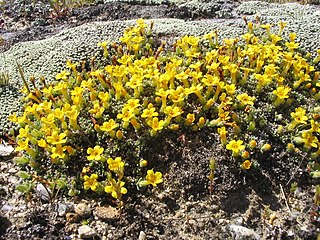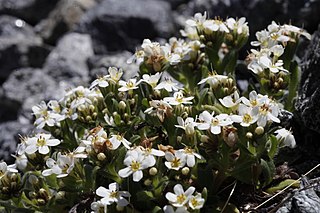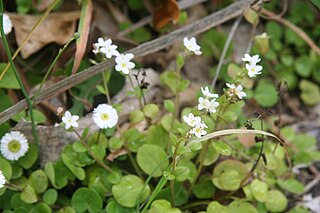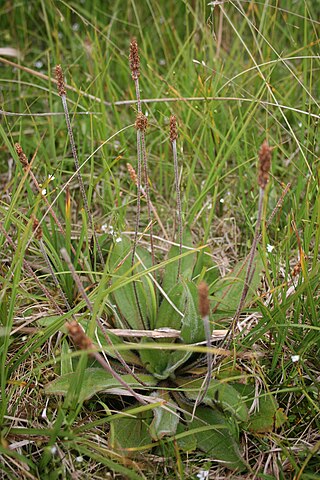
Plantago aucklandica is a species of flowering plant in the family Plantaginaceae that is endemic to the subantarctic Auckland Islands, New Zealand. Joseph Dalton Hooker described P. aucklandica in his Flora Antarctica in 1844. Plants of this plantain are large with large leaves, up to seven veins, wide petioles, colliculate seeds, and long spikes with dozens of flowers and one-seeded fruits. This species in considered to be At Risk - Naturally Uncommon, as it is an island endemic with a restricted range.

Plantago triantha is a species of flowering plant in the family Plantaginaceae that is native to Tasmania, Australia and the subantarctic Auckland Islands of New Zealand. Robert Brown described the species in 1810. Plants of this species of plantain are annual or perennial with a rosette habit, fleshy toothed leaves, and short inflorescences.

Myosotis bryonoma is a species of flowering plant in the family Boraginaceae, endemic to the South Island of New Zealand. Heidi Meudt, Jessica Prebble and Michael Thorsen described the species. Plants of this species of forget-me-not are perennial with a creeping habit, bracteate inflorescences, and white corollas.
Myosotis glabrescens is a species of flowering plant in the family Boraginaceae, endemic to the South Island of New Zealand. Lucy Moore described the species in 1961. Plants of this species of forget-me-not are tightly compacted, perennial mats with bracteate inflorescences and white corollas.

Myosotis pulvinaris is a species of flowering plant in the family Boraginaceae, endemic to the South Island of New Zealand. Joseph Dalton Hooker described the species in 1867. Plants of this species of forget-me-not are perennial with a prostrate, compact, cushion habit, short bracteate inflorescences, and white corollas.

Myosotis uniflora is a species of flowering plant in the family Boraginaceae, endemic to the South Island of New Zealand. Joseph Dalton Hooker described the species in 1867. Plants of this species of forget-me-not are perennial with a prostrate, compact, cushion or mat habit, short bracteate inflorescences, and cream to yellow corollas.

Myosotis lyallii is a species of flowering plant in the family Boraginaceae, endemic to New Zealand. Joseph Dalton Hooker described the species in 1853. Plants of this species of forget-me-not are perennial with a prostrate habit, bracteate or partially-bracteate inflorescences, and white corollas.

Myosotis lyalliisubsp. elderi is a subspecies of flowering plant in the family Boraginaceae, endemic to New Zealand. Lucy Moore described Myosotis elderi in 1961, and Heidi Meudt and Jessie Prebble treated it as a subspecies of M. lyallii in 2018. Plants of this subspecies of forget-me-not are perennial with a prostrate habit, bracteate inflorescences, and white corollas with partially exserted anthers.
Myosotis lyalliisubsp. lyallii is a subspecies of flowering plant in the family Boraginaceae, endemic to the South Island of New Zealand. Joseph Dalton Hooker described M. lyallii in 1853. Plants of this subspecies of forget-me-not are perennial with a prostrate habit, bracteate or partially-bracteate inflorescences, and white corollas, usually with exserted anthers.

Myosotis pansa subsp. praeceps is a subspecies of flowering plant in the family Boraginaceae, endemic to the North Island of New Zealand. Lucy Moore described the variety M. petiolata var. pansa in 1961, and it was transferred to a subspecies of M. pansa by Heidi Meudt, Jessica Prebble, Rebecca Stanley and Michael Thorsen in 2013. Plants of this species of forget-me-not are perennial rosettes with partially bracteate inflorescences and white corollas with exserted stamens.

Myosotis petiolata is a species of flowering plant in the family Boraginaceae, endemic to the Hawkes Bay region of the North Island of New Zealand. Joseph Dalton Hooker described the species in 1853. Plants of this species of forget-me-not are perennial rosettes with ebracteate inflorescences and white corollas with exserted stamens.

Plantago obconica is a species of flowering plant in the family Plantaginaceae that is endemic to the South Island of New Zealand. William Sykes described the species in 1988. It is the smallest Plantago species in New Zealand. Plants of this species of plantain are perennial with a rosette habit, with very narrow, linear, keeled leaves, and fruiting capsules with a 1-cm long funnel-like base.

Plantago triandra is a species of flowering plant in the family Plantaginaceae that is endemic to New Zealand. Sven Berggren described the species in 1877. Plants of this species of plantain are perennial with a rosette habit, with angular-ovate leaves, tiny calyces, numerous seeds, and often sessile flowers and fruiting capsules. The species is considered to be not threatened.

Plantago unibracteata is a species of flowering plant in the family Plantaginaceae that is endemic to New Zealand. Knud Rahn gave the species its current name in 1996, based on Joseph Dalton Hooker's original description in 1854. Plants of this species of plantain are perennial with a rosette habit, with narrowly angular-ovate leaves with few teeth, and numerous angular or rounded seeds.

Plantago lanigera is a species of flowering plant in the family Plantaginaceae that is endemic to New Zealand. Joseph Dalton Hooker described P. lanigera in 1864. Plants of this species of plantain are perennial with a rosette habit, leaves widest above the middle, few small angular to rounded seeds per capsule, glabrous bracts and sepals, and punctate leaves. It is listed as Not Threatened.

Plantago spathulata is a species of flowering plant in the family Plantaginaceae that is endemic to New Zealand. Joseph Dalton Hooker described P. spathulata in 1853. Plants of this species of plantain are perennial with a rosette habit, leaves widest above the middle, up to 4 ellipsoid seeds per capsule, bracts with hairs along the edges, and midribs of bracts and sepals hairy. It is listed as Not Threatened.

Plantago picta is a species of flowering plant in the family Plantaginaceae that is endemic to New Zealand. William Colenso described P. picta in 1890. Plants of this species of plantain are perennial with a rosette habit, leaves widest above the middle, up to 5 ellipsoid seeds per capsule, and bracts with hairs along the edges but otherwise glabrous. Its conservation status is At Risk – Naturally Uncommon.

Plantago raoulii is a species of flowering plant in the family Plantaginaceae that is endemic to New Zealand. Joseph Decaisne described P. raoulii in 1852. Plants of this species of plantain are perennial with a rosette habit, leaves widest above the middle, usually 5 seeds in a specific arrangement in each capsule, and bracts with mostly glabrous edges. It is listed as Not Threatened.

Plantago udicola is a species of flowering plant in the family Plantaginaceae that is endemic to New Zealand. Heidi Meudt and Philip Garnock-Jones described P. udicola in 2012. Plants of this species of plantain are perennial with a rosette habit, leaves widest above the middle, seeds uniform, ellipsoid and 1–4 per capsule, edges of bracts sparsely hairy, edges of sepals with isolated hairs at the apex only, and a chromosome number of 2n = 96 (dodecaploid). It is listed as Not Threatened.

Ourisia caespitosa, or creeping mountain foxglove, is a species of flowering plant in the family Plantaginaceae that is endemic to New Zealand. Joseph Dalton Hooker described O. caespitosa in 1853. Plants of this species of New Zealand foxglove are perennial herbs that are mostly glabrous (hairless), with trilobed or irregularly notched leaves that are tightly packed along a creeping stem. It is listed as Not Threatened.























